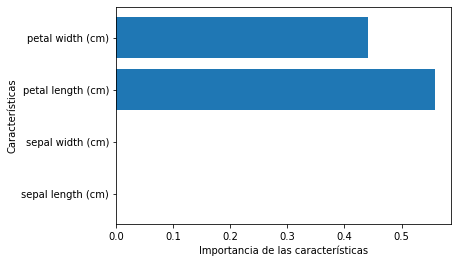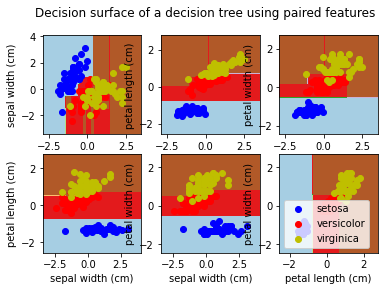Arboles de desición
Contents
Arboles de desición¶
Proporcionan una represetancion grafica del proceso de desiscion secuencial
Puntos de desición y alternativas
#https://www.codificandobits.com/blog/clasificacion-arboles-decision-algoritmo-cart/
from sklearn.datasets import make_classification
X0, y0 = make_classification(n_samples=20,
n_features=2, n_redundant=0, n_informative=1, random_state=1,
n_clusters_per_class=1)
x=np.arange(-2, 3,1)
x_,y_ = np.meshgrid(x,x)
fig, ax = plt.subplots()
ax.plot(X0[:,0][y0==0],X0[:,1][y0==0],"ro", alpha=0.5)
ax.plot(X0[:,0][y0==1],X0[:,1][y0==1],"bo", alpha=0.5)
ax.plot(x_,y_,"k.")
ax.axvline(x = 1, color = 'm', label="x1<=1")
ax.axhline(y = 0.2, color = 'y', label="x2<0.2")
ax.axvline(x = 0.0, color = 'k', label="x2<0.2")
plt.legend(loc=3)
---------------------------------------------------------------------------
NameError Traceback (most recent call last)
Input In [1], in <cell line: 7>()
2 from sklearn.datasets import make_classification
3 X0, y0 = make_classification(n_samples=20,
4 n_features=2, n_redundant=0, n_informative=1, random_state=1,
5 n_clusters_per_class=1)
----> 7 x=np.arange(-2, 3,1)
8 x_,y_ = np.meshgrid(x,x)
10 fig, ax = plt.subplots()
NameError: name 'np' is not defined
ref https://www.youtube.com/watch?v=kqaLlte6P6o&ab_channel=CodificandoBits
Hand on Machine leargning
Gini index
$G=1- (PC 1)^2-(PC 2)^2$
-Si se tiene puntos perteniecientes a una clase despues de trazar la primera se tienen nodos puros. $G=0$ Datos de una sola categoria
Gini > 0 son datos con impurezas
La particion purpura y amarilla del grafico anterior represetan nodos puros.
Mientras que la linea negra define: Si : $G=1-(7/12)^{2}-(5/12)^{2}$
mientras que la ponderacion viene dada por: m = (7/20+6/20)
No:
$G=1-(3/7)^{2}-(4/7)^{2}$ m = (3/20+4/20)
La funcion de coste, asocida al nodo padre:
$J(k, t_k) = \frac{m_{left}}{m} G_{left} + \frac{m_{right}}{m} G_{right} $
Entropía de Gini.
$H=-\sum_{k=1\ p_{ik!=0}}^{n} p_{ij}\log_2(p_{ik})$
from sklearn.tree import DecisionTreeClassifier
from sklearn.datasets import load_iris, load_breast_cancer
from sklearn.model_selection import train_test_split
import graphviz
#from sklearn.tree import export_graphviz
import matplotlib.pyplot as plt
import numpy as np
from sklearn import tree
# Libraries for draw contours
def make_meshgrid(x, y, h=0.02):
"""Create a mesh of points to plot in
Parameters
----------
x: data to base x-axis meshgrid on
y: data to base y-axis meshgrid on
h: stepsize for meshgrid, optional
Returns
-------
xx, yy : ndarray
"""
x_min, x_max = x.min() - 1, x.max() + 1
y_min, y_max = y.min() - 1, y.max() + 1
xx, yy = np.meshgrid(np.arange(x_min, x_max, h), np.arange(y_min, y_max, h))
return xx, yy
def plot_contours(ax, clf, xx, yy, **params):
"""Plot the decision boundaries for a classifier.
Parameters
----------
ax: matplotlib axes object
clf: a classifier
xx: meshgrid ndarray
yy: meshgrid ndarray
params: dictionary of params to pass to contourf, optional
"""
Z = clf.predict(np.c_[xx.ravel(), yy.ravel()])
Z = Z.reshape(xx.shape)
out = ax.contourf(xx, yy, Z, **params)
return out
def plot_contoursExact(ax, xx, yy, **params):
"""Plot the decision boundaries for a classifier.
Parameters
----------
ax: matplotlib axes object
clf: a classifier
xx: meshgrid ndarray
yy: meshgrid ndarray
params: dictionary of params to pass to contourf, optional
"""
Z = clf.predict(np.c_[xx.ravel(), yy.ravel()])
Z = Z.reshape(xx.shape)
out = ax.contourf(xx, yy, Z, **params)
return out
iris = load_iris()
X_train, X_test, y_train, y_test = train_test_split(iris.data, iris.target,\
test_size=0.33, random_state=42)
DecisionTreeClassifier?
clf = DecisionTreeClassifier(max_depth=2)
clf.fit(X_train, y_train)
print(f"{clf.score(X_test, y_test)} ")
print(f"{clf.score(X_train, y_train)}" )
0.98
0.95
tree.export_graphviz?
# https://scikit-learn.org/stable/modules/generated/sklearn.tree.export_graphviz.html
# save graph, put out_file with the name
arbol = tree.export_graphviz(clf, out_file=None,
class_names = iris.target_names,\
feature_names = iris.feature_names,\
impurity=False, filled=True)
!ls
sample_data
tree.plot_tree?
fig, axes = plt.subplots(nrows = 1,ncols = 1,figsize = (4,4), dpi=300)
graph=tree.plot_tree(clf,class_names = iris.target_names,\
feature_names = iris.feature_names,\
impurity=False, filled=True,rounded=True )

Importancia de las cacracteristicas¶
clf.feature_importances_
array([0. , 0. , 0.55816894, 0.44183106])
caract = iris.data.shape[1]
plt.barh(range(caract), clf.feature_importances_)
plt.yticks(np.arange(caract),iris.feature_names)
plt.xlabel('Importancia de las características')
plt.ylabel('Características')
plt.show()

# https://scikit-learn.org/stable/modules/generated/sklearn.model_selection.train_test_split.html
# Parameters
n_classes = 3
plot_colors = "bry"
plot_step = 0.02
# Load data
iris = load_iris()
for pairidx, pair in enumerate([[0, 1], [0, 2], [0, 3],
[1, 2], [1, 3], [2, 3]]):
# We only take the two corresponding features
X = iris.data[:, pair]
y = iris.target
# Shuffle
idx = np.arange(X.shape[0])
np.random.seed(13)
np.random.shuffle(idx)
X = X[idx]
y = y[idx]
# Standardize
mean = X.mean(axis=0)
std = X.std(axis=0)
X = (X - mean) / std
# Train
clf = DecisionTreeClassifier().fit(X, y)
# Plot the decision boundary
plt.subplot(2, 3, pairidx + 1)
x_min, x_max = X[:, 0].min() - 1, X[:, 0].max() + 1
y_min, y_max = X[:, 1].min() - 1, X[:, 1].max() + 1
xx, yy = np.meshgrid(np.arange(x_min, x_max, plot_step),
np.arange(y_min, y_max, plot_step))
Z = clf.predict(np.c_[xx.ravel(), yy.ravel()])
Z = Z.reshape(xx.shape)
cs = plt.contourf(xx, yy, Z, cmap=plt.cm.Paired)
plt.xlabel(iris.feature_names[pair[0]])
plt.ylabel(iris.feature_names[pair[1]])
plt.axis("tight")
# Plot the training points
for i, color in zip(range(n_classes), plot_colors):
idx = np.where(y == i)
plt.scatter(X[idx, 0], X[idx, 1], c=color, label=iris.target_names[i],
cmap=plt.cm.Paired)
plt.axis("tight")
plt.suptitle("Decision surface of a decision tree using paired features")
plt.legend()
plt.show()

